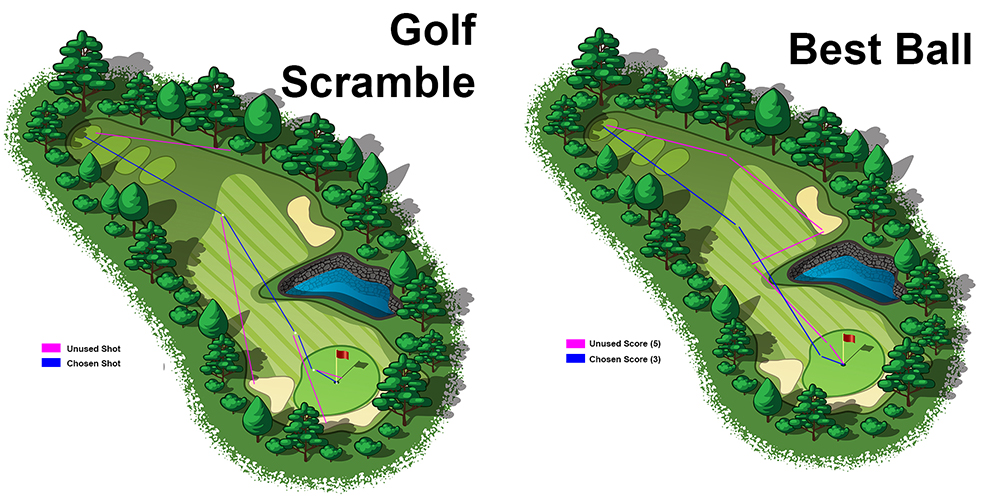As an Amazon Associate GolferHive.com earns from qualifying purchases.
What Is a Golf Scramble? A Beginner’s Guide to the Rules
Ever been invited to a charity golf tournament or a corporate outing and heard the term ‘scramble’? If you’re not a seasoned golfer, this might leave you wondering exactly what you’ve signed up for. You might be asking, “What is a golf scramble?”, “How do you play?”, and “Will I be holding my team back?” This guide is designed to answer all those questions and more, turning you from a curious beginner into a confident and valuable scramble teammate.
A golf scramble is a popular team-based format where all players on a team hit a shot, select the best one, and all play their next shot from that spot. This process continues until the ball is in the hole, with only one team score per hole.
Leveraging extensive analysis of established tournament rules and player experiences, this guide unpacks everything you need to know. We’ll walk you through the step-by-step process of playing, explain common variations you might encounter, and even provide simple strategies to help your team perform its best. By the end, you’ll understand why the golf scramble is the most popular and fun format for social golf events.
Key Facts
- Designed for Inclusivity: The scramble format is intentionally designed to be enjoyable for all skill levels, from scratch golfers to total beginners, because individual bad shots don’t penalize the team.
- Faster Than Traditional Golf: By always playing from the best shot and reducing time spent looking for lost balls, scrambles significantly speed up the pace of play, a key reason they’re chosen for large events.
- The “One Club-Length” Rule is Key: In the fairway or rough, players can typically place their ball within one club-length of the selected shot (no closer to the hole), but this advantage does not apply if the best shot is in a hazard like a sand bunker.
- It’s Not “Best Ball”: In a scramble, everyone plays from the same spot after each shot. In a “Best Ball” tournament, every player plays their own ball for the entire hole.
- Variations Add Strategy: Common variations like the “Texas Scramble” require teams to use a minimum number of tee shots from each player, adding a layer of strategy to the game.
What Is a Golf Scramble? A Clear Definition for Beginners
A golf scramble is a team-based format where all players on a team hit a shot, select the best one, and all play their next shot from that spot. This process continues until the ball is in the hole, with only one team score per hole. It’s the most common format for charity events and corporate outings because it removes the pressure of individual performance and emphasizes teamwork and fun.

It’s crucial to understand the difference between the format and the term “scrambling” in golf.
In golf terminology, “scrambling” refers to a player recovering from an error to save par. For example, if you hit your tee shot into the woods but still manage to make par on the hole, you have successfully “scrambled.” The golf scramble format, however, is a team game and is completely different.
This distinction is key. When someone invites you to a what’s a golf scramble event, they are inviting you to a fun, low-pressure team game, not a high-stakes individual competition.
How a Golf Scramble Works: A Step-by-Step Guide to Playing a Hole
Understanding how a golf scramble works is simple once you see it broken down. The core concept is “hit, select, repeat.” Here is a step-by-step guide to playing a single hole in a typical four-person what’s a golf scramble tournament.
- Everyone Tees Off: All four players on the team hit their tee shot.
- Select the Best Shot: The team walks or drives up to where the four balls landed. They then collectively decide which single shot is in the best position. This isn’t always the longest drive! Factors like the ball’s lie (is it in the fairway or thick rough?), the angle to the green, and any obstructions are just as important. Once chosen, the spot is marked, usually with a tee or a ball marker.
- Everyone Plays from That Spot: The other three players pick up their balls and bring them to the location of the selected best shot. All four players then hit their second shot from this spot, following specific placement rules (more on that below).
- Repeat the Process: After all four players have hit their second shots, the team again selects the best one. They mark the spot, and all four players hit their third shot from there.
- Continue Until the Ball is Holed: This “best ball” process continues for every shot, including chips and putts, until one team member’s shot goes into the hole. The team’s score for that hole is the total number of strokes taken to get the ball in the cup.
Pro Tip: When selecting the best shot, it’s not always the longest drive! Consider the lie and the angle to the green. A ball 20 yards shorter but in the middle of the fairway is often a much better choice than a longer shot sitting in deep rough or behind a tree.

Understanding Ball Placement and Scoring Rules
The specific rules of a what’s a golf scramble are what make the format so advantageous and fun. Knowing how to properly place your ball and how scoring works is essential.
Ball Placement Rules
Once the team’s best shot is selected, the other players don’t just drop their balls anywhere. There are rules for placement:
* In the Fairway or Rough: You can typically place your ball within one club-length of the original ball’s spot. Critically, you cannot place it any closer to the hole. The ball must also stay in the same condition of ground (e.g., if the best shot is in the rough, you must place your ball in the rough).
* On the Putting Green: The placement area is much smaller. You can place your ball within four inches or a putter’s head length of the original ball’s spot, again, no closer to the hole. This allows every teammate to putt from the exact same line.
* In a Hazard (Sand or Water): There is no one club-length advantage here. If your team’s best shot lands in a sand bunker, all players must hit their next shot from that exact same spot within the bunker.
Quick Fact: The ‘one club length’ rule is a huge advantage, but remember—it never applies if your best shot is in a hazard!
Scoring Example
Scoring is simple: one score per hole for the whole team. The team with the lowest total score for all 18 holes wins. If there’s a tie, organizers may use a random hole for tie-breaks.
| Hole | Team A Strokes | Team B Strokes |
|---|---|---|
| Hole 1 (Par 4) | 3 (Birdie) | 4 (Par) |
| Hole 2 (Par 3) | 3 (Par) | 3 (Par) |
| Hole 3 (Par 5) | 4 (Eagle) | 5 (Birdie) |
| Total | 10 | 12 |
Why Scrambles Are So Popular (Especially for Charity & Corporate Events)
There’s a reason the what’s a golf scramble format is the default choice for thousands of social, charity, and corporate golf events every year. It’s built on a foundation of fun, speed, and teamwork, which solves many of the challenges of traditional golf.
Think of it as the ultimate team sport on the golf course, where everyone contributes to success and no single player has to carry the burden.
- Less Pressure & More Fun: This is the biggest benefit. Because the team always plays from the best shot, a bad shot from one player is instantly erased. This removes the intense individual pressure that can make golf intimidating for beginners or high-handicap players. Everyone gets to experience hitting from great spots in the fairway and putting for birdie, making the game more enjoyable for all.
- Faster Pace of Play: A traditional round of golf can take over five hours. A golf scramble is much faster. There’s no time wasted looking for lost balls or hitting difficult recovery shots from the woods. The “best ball” approach keeps the game moving, which is essential for managing large fields of players in a tournament setting.
- Great for Teamwork: The format naturally fosters communication and camaraderie. Teammates have to work together on every shot to decide on the best position and strategy. It’s a shared experience of highs (sinking a long putt) and lows (everyone missing!), which is perfect for corporate team-building and social networking.
- Ideal for All Skill Levels: A team can consist of a great golfer, two average players, and a complete non-golfer, and still have a fantastic time and be competitive. The beginner might only contribute one or two shots all day, but they are still an integral part of the team’s decision-making and success. This inclusivity is why it’s the perfect format for fundraisers that need to attract a wide range of participants.
Common Golf Scramble Format Variations You Might Encounter
While the standard what’s a golf scramble is the most common, event organizers love to add twists to make things more interesting. Here are some of the most popular variations you might see.
| Variation Name | Key Rule / Twist | What It Adds |
|---|---|---|
| Texas Scramble | The team must use a minimum number of tee shots from each player (e.g., 4 drives per player in a 4-person team). | Strategy and pressure. It ensures no single player’s drive is used on every hole and forces the team to strategically use drives from weaker players. |
| Florida Scramble | The player whose shot is selected must sit out (step aside) the next stroke. | Team balance. This prevents one great player from dominating a hole and forces every team member to contribute to subsequent shots. |
| Las Vegas Scramble | A six-sided die is rolled before teeing off. Numbers 1-4 correspond to players whose drive must be used. A 5 or 6 allows a free choice. | A fun element of luck and chance. It can force a team to use a poor drive, completely changing the strategy for a hole. |
| Ambrose | This is a standard scramble that incorporates a team handicap. The team’s handicap is subtracted from their gross score to get a net score. | Fairness and competition. It allows teams with higher-handicap players to compete on a level playing field with teams full of skilled golfers. |
Strategy for Your First Scramble: How to Be a Great Teammate
You don’t need to be a scratch golfer to be a huge asset in a what’s a golf scramble. A little bit of strategy and good communication can make a massive difference. Here are the keys to being a great teammate.
- Playing Order is Crucial: Don’t just hit when you’re ready. A smart playing order can give your team a big advantage.
- Off the Tee: Let your most consistent, straightest hitter go first to ensure a “safe” ball is in play. This frees up the longer, more aggressive hitters to go last and try to bomb a drive without fear.
- On the Green: The putting order is the most important strategic decision you’ll make.
Pro Tip: The best putter should almost always go last. They get to see the line and speed from their teammates’ attempts, giving them the best chance to sink the putt! Let the weaker putters go first to show the line.
- Smart Shot Selection: Remember, the longest shot isn’t always the best shot. Always have a quick team discussion. A 150-yard shot from a perfect lie in the fairway is almost always better than a 130-yard shot from a divot or deep rough.
- Communication is Everything: Talk to your teammates! Discuss club selection, wind direction, and putting lines. A golf scramble is a team game, and four heads are better than one. Even if you’re a beginner, your perspective on a putt’s break might be the one that helps your teammate sink it.
Scramble vs. Best Ball: Understanding the Key Difference
This is the most common point of confusion in golf formats. While the names sound similar, “Scramble” and “Best Ball” are fundamentally different games. Getting this right is key to understanding what’s a golf scramble.

Here is a direct, head-to-head comparison to make it crystal clear:
| Feature | Scramble | Best Ball (or Four-Ball) |
|---|---|---|
| Playing Your Ball | All teammates play every shot from the same location (the spot of the team’s selected “best ball”). | Each player plays their own ball from start to finish on the hole. |
| Number of Balls in Play | Only one ball is ever played forward after the tee shot. | All four players’ balls are in play for the entire hole. |
| Scoring | The team has one score, which is the total number of strokes taken using the “best ball” sequence. | The team’s score for the hole is the single lowest score from one of the four individual players. |
| Best For | Beginners, social events, fast pace of play, and low-pressure fun. | More competitive play, as it still requires each player to complete the hole individually. |
The takeaway is simple: in a what’s a golf scramble, you are always playing from your teammate’s best shot. In Best Ball, you are always playing your own ball.
To help you perform your best and make the most of the team format, having the right equipment like high-visibility golf balls can be a huge advantage.
FAQs About what’s a golf scramble
Here are answers to some of the most frequently asked questions about the what’s a golf scramble format.
How do you calculate handicaps for a scramble?
Since official golf rule books don’t cover scrambles, organizers create their own handicap rules. A common formula for a four-person team is to take a descending percentage of each player’s course handicap and add them together. For example: 20% of Player A’s handicap + 15% of Player B’s + 10% of Player C’s + 5% of Player D’s. This total is then subtracted from the team’s final gross score.
Can a total beginner play in a golf scramble?
Yes, absolutely! The what’s a golf scramble format is the perfect introduction to golf for a total beginner. It is designed to be low-pressure and fun for everyone, regardless of skill level.
* Your bad shots don’t hurt the team, as they just pick up your ball and move to the best shot.
* You get to hit from great positions all day long.
* It’s a team effort, so you can learn from your more experienced partners.
What is the difference between a scramble and a shamble?
A shamble (sometimes called a Bramble) is a hybrid format. In a shamble, everyone scrambles off the tee and selects the best drive. From that point, every player plays their own ball individually until it’s holed. The team then takes the lowest individual score on the hole. So, it’s a scramble off the tee, and then essentially a best ball format for the rest of the hole.
Are there different rules for a 2-person scramble vs a 4-person scramble?
The fundamental rules of a 2-person and 4-person what’s a golf scramble are the same: select the best shot and both/all players hit from there. However, handicap calculations are often applied differently and are more common in 2-person events to ensure fair competition. Some rules, like requiring a minimum number of drives from each player, may also be adjusted for the smaller team size.
Final Summary: You’re Ready for Your First Golf Scramble
Now you know exactly what’s a golf scramble. It’s not an intimidating test of skill, but a fun, social, and fast-paced team version of golf designed for everyone to enjoy. By understanding the rules, basic strategy, and key differences from other formats, you are fully prepared to be a confident and contributing member of any scramble team.
- It’s a Team Game: You always play from the best shot, so relax and have fun.
- The Rules are for Fun and Speed: Everything is designed to keep the game moving and enjoyable for all skill levels.
- It is NOT Best Ball: Remember, in a scramble, you play as a team from one spot on every stroke.
Now you know the rules and basic strategy. Go have fun at your next charity tournament or company outing and enjoy the game
Last update on 2025-09-15 / Affiliate links / Images from Amazon Product Advertising API

